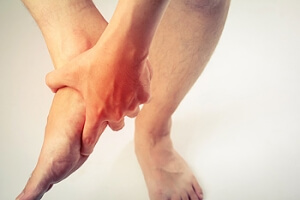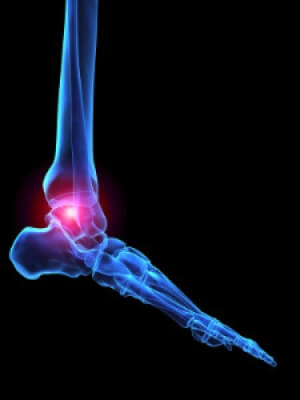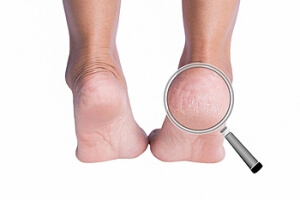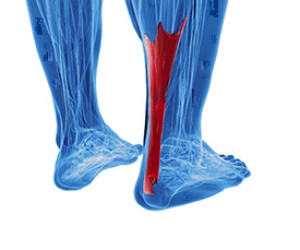BLOG

Low-Impact Exercise and Foot Pain
 Foot pain is experienced by many patients, and it can occur for several reasons. Wearing shoes that do not fit properly, being obese, and incurring injuries to the feet are possible reasons for mild to severe foot pain. Relief may be found when shoes fit correctly. Additionally, it may be beneficial to frequently perform foot and calf stretches which can help to strengthen the overall foot. Low-impact aerobic activities can be helpful in increasing mobility, and these can include cycling, yoga, swimming, and walking. It is strongly advised that you consult with a podiatrist as quickly as possible if you are experiencing foot pain for any reason. Your local podiatrist can determine the cause and offer treatment techniques.
Foot pain is experienced by many patients, and it can occur for several reasons. Wearing shoes that do not fit properly, being obese, and incurring injuries to the feet are possible reasons for mild to severe foot pain. Relief may be found when shoes fit correctly. Additionally, it may be beneficial to frequently perform foot and calf stretches which can help to strengthen the overall foot. Low-impact aerobic activities can be helpful in increasing mobility, and these can include cycling, yoga, swimming, and walking. It is strongly advised that you consult with a podiatrist as quickly as possible if you are experiencing foot pain for any reason. Your local podiatrist can determine the cause and offer treatment techniques.
Foot Pain
Foot pain can be extremely painful and debilitating. If you have a foot pain, consult with one of our podiatrists from Livingston Foot Care Specialists. Our doctors will assess your condition and provide you with quality foot and ankle treatment.
Causes
Foot pain is a very broad condition that could be caused by one or more ailments. The most common include:
- Bunions
- Hammertoes
- Plantar Fasciitis
- Bone Spurs
- Corns
- Tarsal Tunnel Syndrome
- Ingrown Toenails
- Arthritis (such as Gout, Rheumatoid, and Osteoarthritis)
- Flat Feet
- Injury (from stress fractures, broken toe, foot, ankle, Achilles tendon ruptures, and sprains)
- And more
Diagnosis
To figure out the cause of foot pain, podiatrists utilize several different methods. This can range from simple visual inspections and sensation tests to X-rays and MRI scans. Prior medical history, family medical history, and any recent physical traumatic events will all be taken into consideration for a proper diagnosis.
Treatment
Treatment depends upon the cause of the foot pain. Whether it is resting, staying off the foot, or having surgery; podiatrists have a number of treatment options available for foot pain.
If you have any questions, please feel free to contact our office located in North Bellmore, NY . We offer the newest diagnostic and treatment technologies for all your foot care needs.
Foot Pain
The feet, being the foundation of the body, carry all of the body’s weight and are therefore prone to experiencing pain and discomfort. If you are experiencing foot pain, it is important to determine where in the foot you are experiencing this pain to help discover the cause of it. While pain can be experienced virtually anywhere in the foot, the most common sites of foot pain are in the heel and ankle.
Heel pain can be due to a multitude of conditions including plantar fasciitis, Achilles tendinitis, and heel spurs. Pain experienced in the ankle can be a sign of an ankle sprain, arthritis, gout, ankle instability, ankle fracture, or nerve compression. In more serious cases, pain in the foot can be a sign of improper alignment or an infection.
Foot pain can be accompanied by symptoms including redness, swelling, stiffness and warmth in the affected area. Whether the pain can be described as sharp or dull depends on the foot condition behind it. It is important to visit your local podiatrist if your foot pain and its accompanying symptoms persist and do not improve over time.
Depending on the location and condition of your foot pain, your podiatrist may prescribe certain treatments. These treatments can include but are not limited to prescription or over-the-counter drugs and medications, certain therapies, cortisone injections, or surgery.
If you are experiencing persistent foot pain, it is important to consult with your foot and ankle doctor to determine the cause and location. He or she will then prescribe the best treatment for you. While milder cases of foot pain may respond well to rest and at-home treatments, more serious cases may take some time to fully recover.
Possible Signs Of Rheumatoid Arthritis
 The medical condition that is known as rheumatoid arthritis can occur from an immune system that is not functioning properly. It can attack the joints in the body, and can cause severe pain and discomfort. Some of the symptoms that are associated with this ailment can consist of swollen and stiff joints, which can cause difficulty in completing daily activities. Additional signs that patients can notice when this condition first develops can include depression, limited range of motion, and a low-grade fever. When rheumatoid arthritis is promptly treated, damage to the joints and cartilage in the feet may be diminished, and the chances of having a heart attack or stroke may be reduced. If you have a tingling feeling in your feet, it is advised that you confer with a podiatrist who can properly diagnose and treat rheumatoid arthritis.
The medical condition that is known as rheumatoid arthritis can occur from an immune system that is not functioning properly. It can attack the joints in the body, and can cause severe pain and discomfort. Some of the symptoms that are associated with this ailment can consist of swollen and stiff joints, which can cause difficulty in completing daily activities. Additional signs that patients can notice when this condition first develops can include depression, limited range of motion, and a low-grade fever. When rheumatoid arthritis is promptly treated, damage to the joints and cartilage in the feet may be diminished, and the chances of having a heart attack or stroke may be reduced. If you have a tingling feeling in your feet, it is advised that you confer with a podiatrist who can properly diagnose and treat rheumatoid arthritis.
Because RA affects more than just your joints, including the joints in your feet and ankles, it is important to seek early diagnosis from your podiatrist if you feel like the pain in your feet might be caused by RA. For more information, contact one of our podiatrists of Livingston Foot Care Specialists. Our doctors will assist you with all of your podiatric concerns.
What Is Rheumatoid Arthritis?
Rheumatoid Arthritis (RA) is an autoimmune disorder in which the body’s own immune system attacks the membranes surrounding the joints. Inflammation of the lining and eventually the destruction of the joint’s cartilage and bone occur, causing severe pain and immobility.
Rheumatoid Arthritis of the Feet
Although RA usually attacks multiple bones and joints throughout the entire body, almost 90 percent of cases result in pain in the foot or ankle area.
Symptoms
- Swelling and pain in the feet
- Stiffness in the feet
- Pain on the ball or sole of feet
- Joint shift and deformation
Diagnosis
Quick diagnosis of RA in the feet is important so that the podiatrist can treat the area effectively. Your doctor will ask you about your medical history, occupation, and lifestyle to determine the origin of the condition. Rheumatoid Factor tests help to determine if someone is affected by the disease.
If you have any questions please feel free to contact our office located in North Bellmore, NY . We offer the newest diagnostic and treatment technologies for all your foot and ankle needs.
Rheumatoid Arthritis in the Feet
Although rheumatoid arthritis attacks multiple bones and joints throughout the entire body, ninety percent of people who actually develop this condition usually do so in the foot or ankle area. Those who develop this kind of arthritis in the feet usually develop symptoms around the toes and forefeet first, before anywhere else. Rheumatoid arthritis appears to have a genetic component. If it runs in the family, then you will be more likely to develop it as well.
Rheumatoid arthritis is an autoimmune disorder in which the body’s own immune system attacks the lining of the membranes surrounding the joints. This causes inflammation of the membrane lining, and the gradual destruction of the joint’s cartilage and even bone.
Some of the most common symptoms that are associated with RA include pain and swelling of the feet. Stiffness in the feet is also another common symptom that people experience. Those who have RA in the feet usually feel the pain in the ball or sole of their feet. This can get to be very painful at times. A person's joints can even shift and become deformed after a period of time.
In order to properly diagnose RA in the feet it is usually necessary for a doctor or podiatrist to evaluate the area. Your doctor will also question you about your medical history, occupation, etc., to determine whether anything in your lifestyle may have triggered the condition. There are a number of tests that may be performed to help diagnose RA, such as a rheumatoid factor test. There is, however, no one single test that will tell you for sure if you have RA. There are different X-rays that can be taken as well to determine if a person has RA in their feet.
There is a range of treatment options for rheumatoid arthritis. Treatment of RA is usually a lifelong process that includes a variety of methods of treatment and therapy. Your doctor can prescribe special shoes that should help with arch support as well as heel support. A physical therapist can help those with this condition learn exercises which will keep their joints flexible. Surgery may be needed to correct some of the issues with the feet, such as bunions, and hammertoes. Fusion is usually the most successful surgical option for rheumatoid arthritis. However, people need to keep in mind that there are some risks associated with these surgeries.
How to Find Mild Relief From Cracked Heels
 The ailment that is known as cracked heels develops as a result of a lack of moisture in the skin. This can happen for a variety of reasons. These may include having specific medical conditions, wearing shoes that have an open back, and standing for long periods of time throughout the day. Fissures in the heel can often feel better when the impacted foot is soaked in warm water, followed by applying a good moisturizer. In severe cases, the cracks in the skin may bleed, and prompt treatment is recommended. If you have developed cracked heels, it is strongly suggested that you consult with a podiatrist who can help you to manage this condition.
The ailment that is known as cracked heels develops as a result of a lack of moisture in the skin. This can happen for a variety of reasons. These may include having specific medical conditions, wearing shoes that have an open back, and standing for long periods of time throughout the day. Fissures in the heel can often feel better when the impacted foot is soaked in warm water, followed by applying a good moisturizer. In severe cases, the cracks in the skin may bleed, and prompt treatment is recommended. If you have developed cracked heels, it is strongly suggested that you consult with a podiatrist who can help you to manage this condition.
If the skin on your feet starts to crack, you may want to see a podiatrist to find treatment. If you have any concerns, contact one of our podiatrists from Livingston Foot Care Specialists. Our doctors can provide the care you need to keep you pain-free and on your feet.
Cracked Heels
It is important to moisturize your cracked heels in order to prevent pain, bleeding, and infection. The reason cracked heels form is because the skin on the foot is too dry to support the immense pressure placed on them. When the foot expands, the dry skin on the foot begins to split.
Ways to Help Heal Them
- Invest in a good foot cream
- Try Using Petroleum Jelly
- Ease up on Soaps
- Drink Plenty of Water
Ways to Prevent Cracked Heels
- Moisturize After Showering
- Skip a Shower
- Keep Shower Water Lukewarm
- Don’t Scrub Your Feet
If you are unsure how to proceed in treating cracked heels, seek guidance from a podiatrist. Your doctor will help you with any questions or information you may need.
If you have any questions, please feel free to contact our office located in North Bellmore, NY . We offer the newest diagnostic and treatment technologies for all your foot care needs.
Solutions for Cracked Heels
Cracked heels may make you want to think twice about showing off your feet in warmer weather. However, cracked heels may be harmful to more than just the appearance of your feet. If deep fissures and cracks develop in your heels, they may make walking and standing painful for you. Additionally, these openings make way for germs to enter through your skin and cause infection.
There are several different causes of cracked heels. One of the most common reasons for this ailment is dry skin. This problem may make your keeps feel rough tight and itchy. Dry skin may be caused by cold air, extremely hot water, harsh soaps, and aging. Skin disorders such as eczema and psoriasis may eventually lead to dry skin. In some cases, complications may arise from cracked heels. Some of these complications are a loss of feeling in the heel, cellulitis, or a diabetic foot ulcer.
There are ways you can try to prevent getting cracked heels. One of the best ways to do so is to avoid wearing flip flops and sandals because these shoes increase your risk of drying out your feet. You should also avoid wearing shoes with a tall skinny heel, because these shoes cause your heel to expand sideways. At night, you should slather on a thick moisturizing cream on your feet and then cover them in socks to keep your feet moisturized overnight. Drinking water to stay hydrated is also a good way to ensure that your skin doesn’t become dry.
If you suffer from a severe case of cracked feet, you should make an appointment with your podiatrist to see what treatment methods are best for you.
How Do Achilles Tendon Injuries Occur?
 The pain that is experienced by patients who have endured an Achilles tendon injury can be debilitating. It can occur as a result of participating in running and jumping activities, or from not warming up before beginning a run. The Achilles tendon is defined as a portion of tissue that is located in the back of the leg. The function is to connect the heel to the calf muscles. It is responsible for the ability to point and flex the toes. If this tendon becomes injured or torn, it may lead to a condition that is known as Achilles tendonitis. Existing medical conditions can contribute to the onset of an Achilles tendon injury. These can include arthritis, structural foot abnormalities, in addition to being overweight. The symptoms that are often associated with this type of injury can consist of swelling, heel pain, and it is generally difficult to walk. If you have injured your Achilles tendon, it is suggested that you speak to a podiatrist who can determine the severity of your injury, and offer you the best treatment options.
The pain that is experienced by patients who have endured an Achilles tendon injury can be debilitating. It can occur as a result of participating in running and jumping activities, or from not warming up before beginning a run. The Achilles tendon is defined as a portion of tissue that is located in the back of the leg. The function is to connect the heel to the calf muscles. It is responsible for the ability to point and flex the toes. If this tendon becomes injured or torn, it may lead to a condition that is known as Achilles tendonitis. Existing medical conditions can contribute to the onset of an Achilles tendon injury. These can include arthritis, structural foot abnormalities, in addition to being overweight. The symptoms that are often associated with this type of injury can consist of swelling, heel pain, and it is generally difficult to walk. If you have injured your Achilles tendon, it is suggested that you speak to a podiatrist who can determine the severity of your injury, and offer you the best treatment options.
Achilles tendon injuries need immediate attention to avoid future complications. If you have any concerns, contact one of our podiatrists of Livingston Foot Care Specialists. Our doctors can provide the care you need to keep you pain-free and on your feet.
What Is the Achilles Tendon?
The Achilles tendon is a tendon that connects the lower leg muscles and calf to the heel of the foot. It is the strongest tendon in the human body and is essential for making movement possible. Because this tendon is such an integral part of the body, any injuries to it can create immense difficulties and should immediately be presented to a doctor.
What Are the Symptoms of an Achilles Tendon Injury?
There are various types of injuries that can affect the Achilles tendon. The two most common injuries are Achilles tendinitis and ruptures of the tendon.
Achilles Tendinitis Symptoms
- Inflammation
- Dull to severe pain
- Increased blood flow to the tendon
- Thickening of the tendon
Rupture Symptoms
- Extreme pain and swelling in the foot
- Total immobility
Treatment and Prevention
Achilles tendon injuries are diagnosed by a thorough physical evaluation, which can include an MRI. Treatment involves rest, physical therapy, and in some cases, surgery. However, various preventative measures can be taken to avoid these injuries, such as:
- Thorough stretching of the tendon before and after exercise
- Strengthening exercises like calf raises, squats, leg curls, leg extensions, leg raises, lunges, and leg presses
If you have any questions please feel free to contact our office located in North Bellmore, NY . We offer the newest diagnostic tools and technology to treat your foot and ankle needs.
Achilles Tendon Injuries
The Achilles tendon is the largest tendon in the body; it is a tough band of fibrous tissue that stretches from the bones of the heel to the calf muscles. This tendon is what allows us to stand on our toes while running, walking, or jumping, it is common for this tendon to become injured. In severe cases, the Achilles tendon may become partially torn or completely ruptured. However, this tendon is susceptible to injury because of its limited blood supply and the high level of tension it endures.
The people who are more likely to suffer from Achilles tendon injuries are athletes who partake in activities that require them to speed up, slow down, or pivot. Consequently, athletes who engage in running, gymnastics, dance, football, baseball, basketball, or tennis are more likely to suffer from Achilles tendon injuries. Additionally, there are other factors that may make you more prone to this injury. People who wear high heels, have flat feet, tight leg muscles or tendons, or take medicines called glucocorticoids are more likely to have Achilles tendon injuries.
A common symptom of an Achilles tendon injury is pain above the heel that is felt when you stand on your toes. However, if the tendon is ruptured, the pain will be severe, and the area may become swollen and stiff. Other symptoms may be reduced strength in the lower ankle or leg area, and reduced range of motion in the ankle. When the Achilles tendon tears, there is usually a popping sound that occurs along with it. People who have acute tears or ruptures may find walking and standing to be difficult.
If you suspect you have injured your Achilles tendon, you should see your podiatrist to have a physical examination. Your podiatrist will likely conduct a series of tests to diagnose your injury including a “calf-squeeze” test. Calf squeeze tests are performed by first squeezing the calf muscle on the healthy leg. This will pull on the tendon and consequently cause the foot to move. Afterward, the same test will be performed on the injured leg. If the tendon is torn, the foot won’t move because the calf muscle won’t be connected to the foot.
Cold Feet May Be a Sign of Poor Circulation
 Patients who have poor circulation may have existing health ailments. This condition can be indicative of serious maladies that may include diabetes, kidney damage, or heart disease. People who sit for the majority of the day may be susceptible to developing poor circulation, but this condition may be avoided by gently stretching during the day. Additionally, eating foods that are unhealthy may put people at an increased risk for poor circulation. Some of the signs people notice can include leg cramps, cold feet, and patients may become unusually tired. If you feel you have this condition and are experiencing any of the above symptoms, it is advised that you seek the counsel of a podiatrist who can properly diagnose and treat poor circulation.
Patients who have poor circulation may have existing health ailments. This condition can be indicative of serious maladies that may include diabetes, kidney damage, or heart disease. People who sit for the majority of the day may be susceptible to developing poor circulation, but this condition may be avoided by gently stretching during the day. Additionally, eating foods that are unhealthy may put people at an increased risk for poor circulation. Some of the signs people notice can include leg cramps, cold feet, and patients may become unusually tired. If you feel you have this condition and are experiencing any of the above symptoms, it is advised that you seek the counsel of a podiatrist who can properly diagnose and treat poor circulation.
While poor circulation itself isn’t a condition; it is a symptom of another underlying health condition you may have. If you have any concerns with poor circulation in your feet contact one of our podiatrists of Livingston Foot Care Specialists. Our doctors will treat your foot and ankle needs.
Poor Circulation in the Feet
Peripheral artery disease (PAD) can potentially lead to poor circulation in the lower extremities. PAD is a condition that causes the blood vessels and arteries to narrow. In a linked condition called atherosclerosis, the arteries stiffen up due to a buildup of plaque in the arteries and blood vessels. These two conditions can cause a decrease in the amount of blood that flows to your extremities, therefore resulting in pain.
Symptoms
Some of the most common symptoms of poor circulation are:
- Numbness
- Tingling
- Throbbing or stinging pain in limbs
- Pain
- Muscle Cramps
Treatment for poor circulation often depends on the underlying condition that causes it. Methods for treatment may include insulin for diabetes, special exercise programs, surgery for varicose veins, or compression socks for swollen legs.
As always, see a podiatrist as he or she will assist in finding a regimen that suits you. A podiatrist can also prescribe you any needed medication.
If you have any questions, please feel free to contact our office located in North Bellmore, NY . We offer the newest diagnostic and treatment technologies for all your foot care needs.






